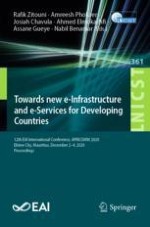
2021 | OriginalPaper | Buchkapitel
TV White Spaces Regulatory Framework for Kenya: An Overview and Comparison with Other Regulations in Africa
verfasst von : Kennedy Ronoh, Leonard Mabele, Dennis Sonoiya
Erschienen in: Towards new e-Infrastructure and e-Services for Developing Countries
Aktivieren Sie unsere intelligente Suche, um passende Fachinhalte oder Patente zu finden.
Wählen Sie Textabschnitte aus um mit Künstlicher Intelligenz passenden Patente zu finden. powered by
Markieren Sie Textabschnitte, um KI-gestützt weitere passende Inhalte zu finden. powered by